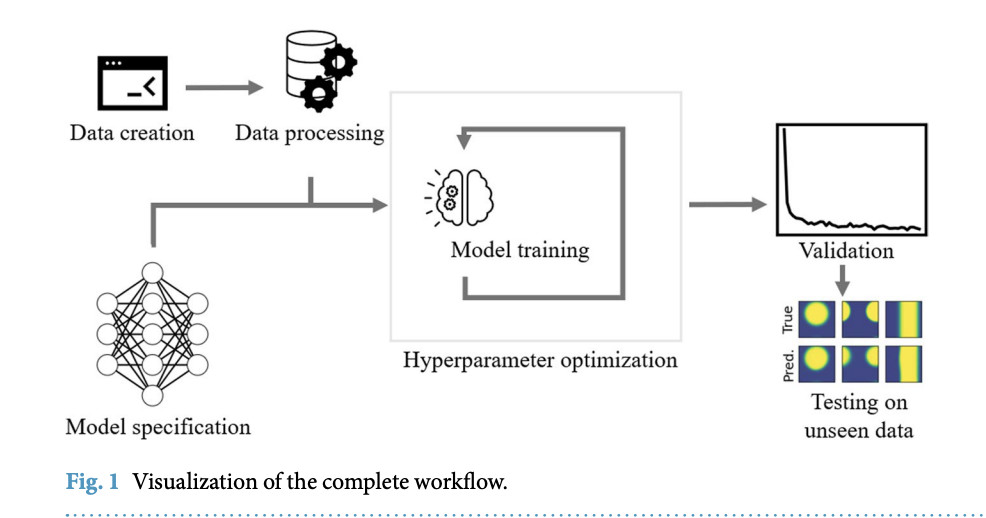

Phase-field models serve as a crucial mesoscale simulation method, bridging atomic-scale models and macroscopic phenomena by describing microstructural evolution and phase transformations. These models extract local free energy density information from lower-scale simulations and use it to predict larger-scale material behavior. Phase-field methods are widely applied in processes such as grain growth, crack propagation, dendrite growth, and membrane dynamics, and they are especially significant in battery materials research. They model lithiation and de-lithiation dynamics, phase boundary movements, and stress-induced degradation during charge-discharge cycles. However, these simulations are computationally intensive, limiting their ability to effectively explore broad design spaces or capture long-time-scale dynamics.
Integrating ML with phase-field modeling offers a promising solution to these computational challenges. ML models, trained on high-quality datasets, can rapidly predict simulation trajectories, enabling faster and more efficient analyses. This hybrid approach combines the strengths of physics-based methods with data-driven models, accelerating material discovery and optimization. Access to large, curated, and physically validated datasets is essential to realize this potential fully. These datasets ensure the reliability of ML predictions and enable systematic studies across multi-dimensional design spaces, fostering advancements in materials science and energy storage technologies.
Researchers from DTU, Slovenia’s National Institute of Chemistry, and the University of Ljubljana introduced a publicly available dataset for benchmarking ML algorithms in phase-field simulations. Using a Cahn-Hilliard equation-based model tailored for lithium iron phosphate (LFP) battery electrodes, they generated a dataset capturing microstructure evolution during lithiation. They validated the dataset using a U-Net-based ML model that predicts entire trajectories without requiring intermediate simulations. The model demonstrated strong accuracy across diverse conditions. This dataset and code provide a valuable resource for developing and testing ML algorithms, facilitating advancements in accelerating phase-field simulations and materials research.
The study describes the phase-field modeling framework and the methodology used to create a database of simulation trajectories. The phase-field model, implemented in computationally efficient C code, solves the Cahn-Hilliard equation, which is widely used for simulating microstructure evolution during phase separation. The chemical potential derives from the total free energy functional, incorporating a gradient penalty term to penalize phase boundaries. The system, parameterized for lithium iron phosphate (LiFePO4) active particles, employs a finite volume method (FVM) for numerical solutions due to its conservation properties and ease of application to complex geometries. Simulations run on high-performance computing (HPC) setup use a parameterized workflow to explore variations in domain size, concentration, and initial conditions, storing results in structured folders. Outputs include concentration fields, chemical potential maps, animations, and time-resolved data, facilitating comprehensive analyses.
The generated dataset comprises 1,100 simulation trajectories, with specific subsets reserved for testing and evaluation. Two popular segmentation architectures, U-Net and SegFormer, were trained using PyTorch on an NVIDIA RTX 3090 GPU to validate the dataset. The U-Net architecture, known for its efficient handling of local and global features, was selected for its simplicity and effectiveness. The SegFormer, a transformer-based architecture, provided a complementary benchmark. Training employed the AdamW optimizer with a learning rate schedule to prevent overfitting. Mean Square Error (MSE) loss was chosen for its superior performance compared to Binary Cross-Entropy (BCE). Both models demonstrated the dataset’s utility, highlighting its potential for machine learning applications in phase-field modeling.
In conclusion, the study introduces a well-documented and accessible dataset designed for benchmarking machine learning algorithms in phase-field simulations, which model mesoscale microstructure phenomena bridging atomic and macroscopic scales. Using the U-Net architecture as a baseline, the dataset was validated through predictive tasks across various domain sizes. Results show that the U-Net achieves competitive error metrics and generalizes effectively to unseen domain sizes. Despite differences in datasets limiting direct comparisons with prior studies, the findings align with existing benchmarks. This dataset supports the development of domain-size-independent models and advances machine-learning approaches for accelerating phase-field simulations.
Check out the Paper. All credit for this research goes to the researchers of this project. Also, don’t forget to follow us on Twitter and join our Telegram Channel and LinkedIn Group. If you like our work, you will love our newsletter.. Don’t Forget to join our 55k+ ML SubReddit.
[FREE AI VIRTUAL CONFERENCE] SmallCon: Free Virtual GenAI Conference ft. Meta, Mistral, Salesforce, Harvey AI & more. Join us on Dec 11th for this free virtual event to learn what it takes to build big with small models from AI trailblazers like Meta, Mistral AI, Salesforce, Harvey AI, Upstage, Nubank, Nvidia, Hugging Face, and more.
The post Accelerating Phase-Field Simulations with Machine Learning: Benchmark Dataset and U-Net Validation appeared first on MarkTechPost.
Source: Read MoreÂ

